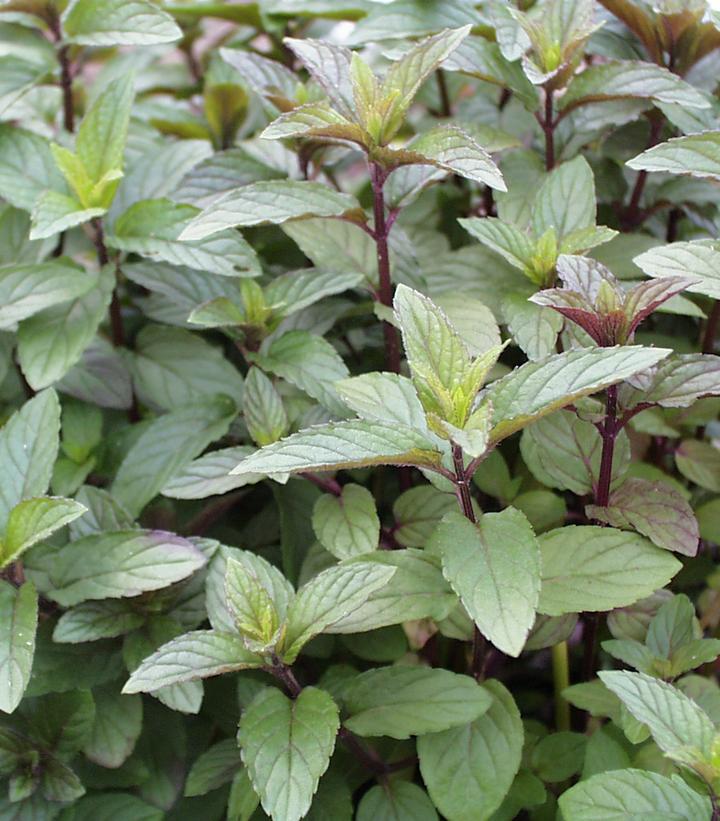

Mentha piperita 'Chocolate'
Chocolate Mint
- Easy to grow
- Chocolatey scent and flavor
- Perfect for flavoring teas and desserts
- Tough, aggressive growth characteristics
- Grows well in the ground but is best in a container
- Included in Recipe(s): Salsa Fresca
- Category: Herbs, Edibles
- Hardiness Zone: 4-8
- Height: 18-36 in
- Spread: 3-5 ft
- Bloom Color: Green Shades
- Foliage Color: Green Shades
A delight for its ease of growth and remarkably strong chocolate scent and flavor, chocolate mint is the perfect herb for flavoring sweets and in a bracing, flavorful herb tea. Chocolate mint will take a licking and keep on growing due to its tough, aggressive growth characteristics and deserves constant pruning since the most pungent, flavorful leaves are its newest ones. Chocolate mint will grow well in the ground but might be best in a container where it can be used year round while controlling its most aggressive tendencies. Perennial.
Additional Information about Mentha piperita 'Chocolate'
M. x piperita 'Chocolate' is a variety of peppermint. This one is a real treat for the discriminating nose, but there are those, unfortunately, who do not detect any chocolate scent and believe it is a figment of the imagination. If you are one of the lucky ones who do, this mint is a wonderful addition to anything chocolate.
Most mints (Mentha) are native to Europe and Asia. Some are native to North and South America, South Africa, and Australia. It is now naturalized from southern Canada to Mexico. The Pharisees in Biblical times paid taxes with mint. The Greeks used it in medicine and in temple rituals. It was strewn to refresh the air in homes and hospitals. Because Philemon and Baucis rubbed the table with mint before serving a meal to Zeus and Hermes, who had been traveling incognito and who had been snubbed by villagers, it has become a symbol of hospitality.
The word mint comes from Minthe, a Greek nymph who had the misfortune to be loved by Pluto. Persephone, not taking kindly to this infidelity, changed her into a lowly plant. But Pluto, taking pity on her, softened her plight by making her fragrant and even more aromatic when tread upon.
Harvest and Use: Peppermint and spearmint were brought to the New World by the colonists to be used as a beverage and as a medicinal. It now has many uses as a medicinal, a culinary, an aromatic, an ornamental, and as a cosmetic.
Mints are a complex group. They hybridize in the wild and under cultivation, often making individual plants hard to identify. It is best to buy plants from a reputable nursery, as mint often does not come true from seed. It is menthol that gives mints their typical smell and taste. It has so many uses that it would be hard to find someone who couldn't use it. Here is one medicinal that tastes good, too.
As is true for all herbs, fresh is best. Dried or frozen are good alternatives. It can also be stored in oil or vinegar. The following syrup is another convenient way to preserve peppermint: Simmer 4 cups of peppermint for 30 minutes in just enough water to cover.
Strain. For each cup of liquid add a cup of sugar, and simmer for 15 minutes. Bottle, label, and date. This may also be frozen in convenient portions.
Begin harvesting as soon as it comes up in spring. The main harvest should be taken as flowering begins.
Growing & Maintenance Tips for Mentha piperita 'Chocolate'
Cultivation: Mints are square-stemmed perennials with tiny pink, purple, or white whorls of flowers on spikes. They grow about 2' tall and are very fragrant. They are hardy to zone 4.
All mints are invasive. To contain them, sink in the ground a bottomless 5-gallon pot with at least a 10-inch height (size of the pot really depends on how much space you want to allocate). Plant your mint in this. The rhizomes are contained by the pot. Never till mints because each stub will become another plant. If you want to grow several varieties, do not plant them close to each other because they will cross-pollinate freely (interbreed) and eventually different varieties will become indistinguishable.
When locating mints, remember that they all thrive in shade and like lots of moisture. They also like well-drained soil, but too much manure of organic matter encourages rust. Frequent cutting keeps mints at their prettiest because it forces them to branch and bush out. In the fall, cut back to the ground. This eliminates places for mint pests to over-winter. In companion planting, grow them where you need to repel aphids, flea beetles, and various cabbage pests. For fleas on your pets, try pennyroyal (Mentha pulegium), which has been used as a flea-repelling herb since the time of the ancient Greeks.
Pests: Mints are susceptible to verticillium wilt, mint rust, and anthracnose. Mint pests include spider mites, aphids, and mint flea beetles.
